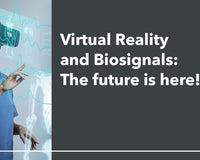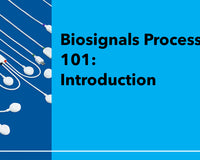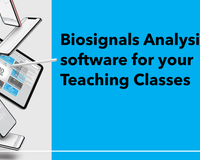Introduction
Biosignal processing is at the heart of modern biomedical engineering and plays a crucial role in various research, healthcare, and off-clinic applications. Its purpose is to enable researchers, clinicians, and developers to unravel the mysteries hidden within the signals generated by the human body to provide critical data for clinical decision-making or even to create interactive Virtual Reality experiences among many other applications.
In this blog post series, we embark on a journey to demystify the world of biosignal processing and explore the techniques and algorithms that empower us to make sense of these complex signals. Whether you are a researcher, a healthcare professional, a developer, or intrigued by the fascinating world of biosignals, it equips you with the knowledge and tools to leverage biosignal processing effectively.
As a bonus, we'll provide our biosignals Notebooks, a collection of Python coding tutorials that demonstrate the implementation of key biosignal processing techniques. These notebooks will allow you to gain hands-on experience and reinforce your understanding of the concepts presented in this blog post.
What you’ll learn in this series?
We’ll be breaking the series into the following blog posts for a digestible and as-you-go learning experience:
-
Introduction (this blog post): What is biosignals processing and where is it needed?
-
Understanding noise & artifacts
-
Pre-processing: removing noise from raw biosignals
-
Feature extraction
-
Real-world use cases of biosignals processing
You’ll find practical biosignals notebooks for hands-on experience in the next blog posts! But first, let's take a moment to understand why biosignal processing holds immense importance and how it is revolutionizing various fields of research and application.
What is biosignals processing?
Biosignals, also known as physiological or biopotential signals, are electrical, mechanical, or chemical signals generated by our body (and living organisms in general, too). These signals carry a wealth of information about our health, emotional responses, and physical performance.
However, raw biosignal data can often be noisy, intricate, and difficult to interpret directly. Although experienced healthcare experts can quickly conduct visual inspections of a signal to identify a variety of normal or abnormal patterns, as for example, cardiologists do when analyzing 10s long Electrocardiograpy (ECG) signal samples, not all information of interest may be immediately visible in the signal and instead be hidden among the signal itself. Especially for the untrained eye.
Enter biosignal processing, a multidisciplinary field that merges principles from signal processing engineering, computer science, and medicine. Its primary objective is to extract meaningful and actionable information from these raw signals, transforming them into comprehensible information for analysis and decision-making.
This can range from making medical parameters available to healthcare professionals, or breaking complex physiological parameters down to understandable information relevant for consumer use, such as, for example, the presentation and impact of heart rate load and performance evaluations in hobby athletes.
Examples of extractable information through biosignal processing
Let’s see a few examples of information that you can extract from biosignals using biosignal processing methods to demonstrate its applications using real biosignals sensors:
-
Electrocardiography (ECG): Extracting heart rate information and its variability under different physical conditions along with the detection of pathological arrhythmia. For instance, a healthy heart has the ability to adapt its heart rate to different physical conditions (e.g. rest vs. physical activity) without showing any signs of pathological issues.
-
Electromyography (EMG): Quantifying the amplitude of EMG signals along the time under controlled and repeated workloads to identify muscle fatigue and potential injury risks.
-
Electroencephalography (EEG): Identify different brainwave frequencies and their activity to reveal different cognitive states. For instance, active brain regions generate quickly changing signals (i.e. high-frequency activity) while at rest, the signal shows only slow changes (i.e. low-frequency activity).
-
Respiration: Extracting respiration rate and identifying breathing patterns while under physical load vs. at rest to differentiate between normal adjustments of respiration to keep the body running with a sufficient oxygen supply and pathological breathing alterations.
There are of course many other biosignals sensors and parameters that can be extracted, but listing them all in this series would lead to a never-ending story. Instead, we encourage to part on your own biosignals journey that starts with this post to explore biosignals that interest you. You can start right here with us.
And before we forget - stay tuned to all the posts of this series as we explore real-world research uses cases in our final chapter!
Where is biosignals processing applied?
The applications of biosignal processing are far-reaching and touch upon numerous research fields. In biomedical engineering, it empowers healthcare professionals to monitor vital signs, make decisions, and design personalized treatment plans. For instance, a cardiologist records Electrocardiography (ECG) signals to identify possible arrhythmias or other heart rate abnormalities, to design a personalized treatment plan consisting of applicable medication and recommendations for lifestyle changes.
But not only the medical field makes use of biosignals and their hidden information. In sports sciences, athletes benefit from biosignal processing by enabling coaches and athletes to evaluate physical performance, optimize training routines, and prevent injuries through precise monitoring. Human-computer interfaces have evolved significantly with the integration of biosignal processing, allowing for intuitive and direct interactions between users and machines based on their physiological responses. This can range from simple consumer-level integration of biosignals to create interactive and immersive virtual reality applications, up to clinical therapy. Additionally, psychophysiology, the study of the relationship between psychological processes and physiological responses, benefits from biosignal processing in understanding emotions, stress, and mental states.
Coming Up: Understanding Noise & Artifacts
As you see, biosignals have long made it out of the clinical context only and take more presence in our everyday lives. You might even have a few sensors yourself in your smartphone and smartwatch that provide you with valuable insights into your health, activity, and lifestyle.
But what if you’d like to extract this information yourself? Stay tuned to this blog post series to learn everything needed to achieve this goal!
In the next post, we’ll have a look at the challenges of working with freshly recorded raw sensor data, primarily how different types of noise sources and interferences. We’ll learn how to identify these noises in our biosignals and once we understand what noise we have, we can properly characterize it and eventually apply filters that fit the present noise best.










